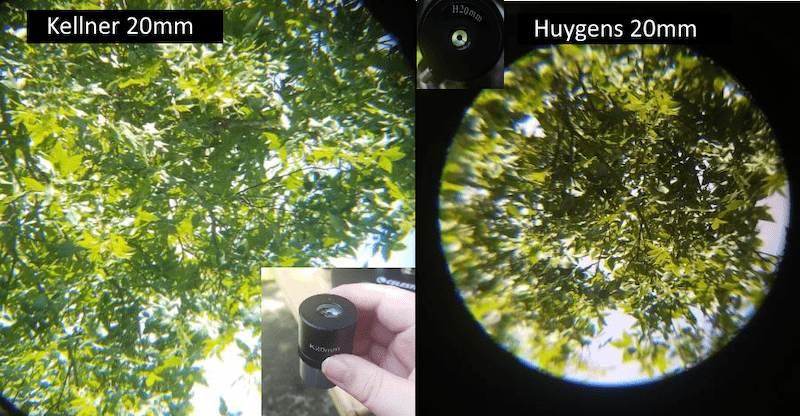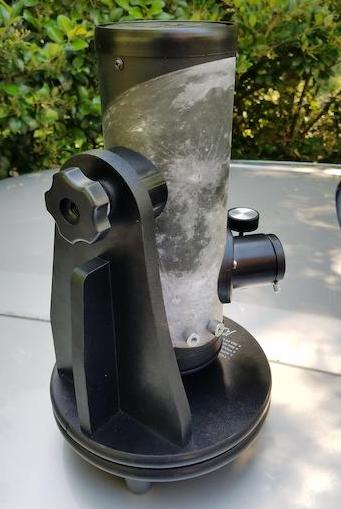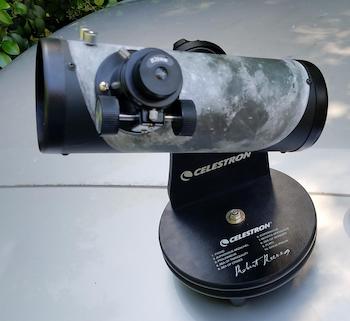The FirstScope Optics Capabilities

Every FirstScope and FirstScope clone (including Orion’s FunScope) has identical optics. The objective is a 76mm (3 inch) spherical mirror with focal length of 300mm, yielding a “fast” focal ratio of F/4. The correct shape for a Newtonian telescope’s primary mirror is a paraboloid, and at this focal ratio, a spherical mirror produces some noticeable aberrations. With aftermarket eyepieces, you can get down to a magnification of 11x and up to no more than 150x. The available magnifications out of the box vary depending upon which model you buy.
The optics of the telescope are not as bad as you might expect just from looking through it–despite claims of it being no better than a shaving mirror, the vast majority of the ugly aberrations come from the Huygens eyepiece.
No matter what you do with the telescope, though, you will see in parts of the field of view blurry, possibly streaky views of extended objects. Stars will only be sharp points at the center of the mirror (which, if the telescope is out of collimation, won’t be at the center of the eyepiece field of view).
However, hidden behind the blurs and the streaks is a crisp, sharp view. It’s as if you had taken a clear photo of the Moon, and put a transparency of a blurry version of that photo on top. If you pay attention, you can still see the sharp view. You just can’t take in a sharp view at a glance. If you pay attention, you can take in all the details of the Moon that a 76mm aperture is capable of delivering, but you have to ignore the ugly bits.
These problems do not affect the optical tube’s performance on fuzzy extended objects, like globular star clusters, bright nebulae, galaxies, and comets. They’re more of a concern for viewing double stars, planets, and the Moon.
The manufacturers of the FirstScope and its clones have not included any method of collimating (or aligning) the telescope’s primary mirror. This wouldn’t be a major problem except that these don’t tend to arrive in good collimation to begin with. It is possible to modify the mirror cell to be collimated, but you’ll need to drill holes in the cell. I haven’t done it myself.
The focuser is a mostly plastic rack-and-pinion design with a lovely smelling, though almost glue-like lubricant globbed on. Try not to get it on your fingers, but it does in fact lubricate the motions of the focuser. Nothing special.
Focuser and Eyepiece Position In FirstScope Clones

The FirstScope and its clones have multiple possible focuser positions. This is actually an important consideration. Point all the telescopes at the horizon. If the eyepiece is on top, you’ll have to bend over the telescope to use it from a seated position. If the eyepiece is straight on the side, you’ll have to bend down to use it from a standing position. An angled position somewhere around 45 degrees is ideal, as it is easy to use both standing over the telescope and sitting down at a table with it. Some people prefer the top position, but I frankly haven’t got the faintest clue why.
When you’re buying a FirstScope, if you can, get one with an angled eyepiece position. You’ll spend much less time figuring out how best to place the firstscope on tables and chairs, and you’ll be able to just grab it and go. The IYA/default version of the FirstScope puts the focuser on top, as does Orion’s FunScope, but pretty much every other variant of the FirstScope and its clones puts the focuser in the angled position.
The Accessories With Different FirstScopes
The FirstScope has several different variants with different accessories, in addition to different decorative wraps covering the tube.

Huygens, Ramsdens, and Symmetrical Ramsdens (H, R, and SR) eyepieces are very cheap two-element eyepieces that deliver spectacularly poor performance. Kellners or Modified Achromats (K or MA) eyepieces are three-element eyepieces, and while they aren’t fantastic, they’re fine eyepieces for a beginner telescope.
Celestron’s FirstScope comes with one of two sets of eyepieces. Either the H20mm and SR4mm eyepiece, the ones I’ve got, or a K20mm and K10mm set of eyepieces. The variants with the Kellners are usually about $10 or so more expensive than the variants with the H20 and SR4.
Orion’s FunScope has a K20mm, a K6mm, and a 2x Barlow. The off-brand FirstScope clones universally have Huygens and Ramsdens.
All of Celestron’s FirstScopes, and the Orion FunScope, come with fittings for a finderscope. Most clones lack such fittings. The FirstScope is intended to be used with a small 5×20 finder, and some variants include this, but the red dot finder included with the FunScope is easier to use.
Which versions have which accessories?
- IYA (default) FirstScope: H20 and SR4.
- Moon by Robert Reeves FirstScope: H20 and SR4.
- Cometron FirstScope: K20 and K10, 5×20 Finderscope.
- COSMOS FirstScope: K20 and K10, Red Dot Finder.
- National Parks Foundation FirstScope: K20 and K10.
- Orion FunScope: K20, K6, 2x Barlow, Red Dot Finder.
- Most knockoff clones will have two huygens or ramsden eyepieces, which might include a very cheap 2x Barlow lens, and no finderscope.
I used my smartphone camera to take a comparison photo of the H20mm eyepiece and a K20mm eyepiece identical to the one that comes with the FunScope.

As you can see, Kellner produces a wider field of view and produces far fewer distortions.
A comparison of the eyepieces shipped with the FirstScopes:
- H20mm: 15x. Small field of view, terrible distortions. Stars near the edge of the view are literally hairy, and since they look like faint fuzzies already, searching for deep sky objects is more difficult.
- K20mm: 15x. Decent field of view, distortions caused by the spherical mirrors are relatively minor. A bit too low to enjoy the Moon. Due to the spherical mirror, stars look like birds when near the edge of the field of view.
- K10mm: 30x. Good power for viewing the Moon, but the field of view and eye relief are slightly less comfortable. Planets are indistinct at this power, but you should see the moons of Jupiter and the elongated shape of Saturn.
- K6mm: 50x. The Moon is as sharp and detailed as it gets with this view, but the small eye lens is a bit uncomfortable. You’ll see the rings of Saturn and, possibly, under very good conditions, the dark belts of Jupiter. I use this in my 6” dob to get very nice views of Jupiter and Saturn as well.
- SR4mm: 75x. Surprisingly decent view, actually–it’s certainly better than the H20. It is, however, far worse than the Kellner. There’s a lot of color fringing due to the optical design, and it produces more noticeable blurry halos around details on the Moon. I have used it to split double stars that the sharper-looking K10mm couldn’t, however.
If you have the H20 and SR4, replace the H20 with a K20 asap, and replace the SR4 with a K6 next. If you have the K20 and K10, a K6 or 6mm Gold-Line will increase the magnification you have access to and give you planet-viewing power.
The Orion FunScope has by far the best accessories, but beware that it is one of the few variants with a focuser on the top.
I find that it’s easy to point at objects near the horizon just by sighting along the tube, but you’ll need to kneel down uncomfortably to sight along the tube when pointing up high. A finder will improve this situation. The 5×20 finder is dim and provides a mostly useless magnification, while a red dot finder is easy to use–it simply projects an image of a red dot onto the sky with no parallax, so once it’s aligned it shows exactly where the telescope is pointed.
Celestron sells an accessory kit which should be avoided. It includes the 5×20 finderscope, a useless greenish moon filter, and two more trash Huygens eyepieces. For the money, I’d buy a red dot finder instead.
The tabletop Dobsonian Mount of FirstScopes

The FirstScope is semi-permanently attached to its mount. The mount is a particle-board standard tabletop dobsonian design. It is designed to be placed on a sturdy table or stool, but I’ve used it on my car hood. Ideally, if you place it on a table or stool, it should have three legs, since three points define a plane, and four legs will wobble unless the ground is completely level and that wobble will be magnified.
A lazy susan allows the telescope to be rotated in azimuth (side to side), while a single-arm with a bearing allows the telescope to be rotated in altitude (up and down). To point the telescope, simply untighten the altitude bearing slightly, grab the telescope tube, and point it to wherever you want. The wonderful simplicity of the dobsonian telescope is echoed in the tabletop dob design. I have never used an easier telescope than the FirstScope.
The Orion FunScope has a fitting for a photo tripod on the bottom of its mount.
What To See
My first look through the FirstScope–one which belonged to my college’s observatory–was of the Moon, and using the Huygens eyepiece, I was not impressed at all. Still, I acquired one as a raffle prize, and over time I learned to love it, especially when paired with decent eyepieces.
Plenty of craters and mountain ranges on the Moon are visible, and throughout most of the Moon’s phases there’s lots of detail to see on the terminator.

Venus’s phases can be seen, when it is at its brightest it is obviously a crescent. Jupiter’s moons can be watched and monitored, and under ideal conditions, the dark equatorial region is just barely visible. Saturn’s rings are visible as “ears” at high power. Under good conditions and with a careful eye, you will be able to just barely see the gap between the rings and the planet. Mercury, bright asteroids, Uranus, and Neptune will be little dots. Don’t even try Pluto.
Dozens of deep sky objects are visible, dependent on light pollution. I’ve observed the M13 globular cluster, the Coat Hanger cluster, and in the morning recently I’ve seen the beautiful Pleiades, the bright core of the Andromeda Galaxy, and the comet NEOWISE.
Many double stars can be seen, though they’ll usually need to be split with a high power eyepiece. Alberio, Mizar, and Cor Caroli are some I’ve seen.

